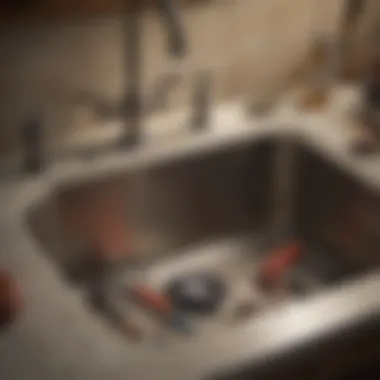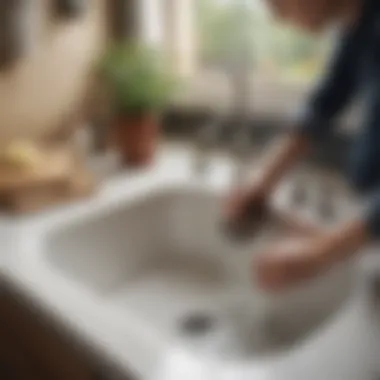Mastering Kitchen Sink Clogs: Essential Unclogging Methods


Intro
Dealing with clogged kitchen sinks can be an aggravating experience. They obstruct daily routines and can lead to unpleasant odors and unsightly water buildup. Understanding the nuances of sink clogs is vital for maintaining an efficient kitchen. This guide lays out a detailed approach to recognizing the causes of clogs, learning effective prevention techniques, and employing various tools to resolve these issues swiftly.
Understanding the Causes of Clogs
Clogs often arise from the accumulation of food particles, grease, and other debris. Over time, these materials can create a blockage in the pipes, leading to slow drainage or complete obstruction. Other contributing factors may include:
- Soap residue: Certain soaps solidify and can stick to pipes.
- Hair and fibers: These can trap grease and food, compounding the problem.
- Foreign objects: Items like utensils may accidentally get lodged in the drain.
Identifying the cause of a clog is the first step in remediating the situation.
Preventive Measures
To avert future clogs, several proactive steps can be taken:
- Regular cleaning: Routinely clean the sink and the drain with hot water and baking soda.
- Use strainers: Placing a strainer over the drain can catch debris before it settles in the pipes.
- Educate household members: Make sure everyone knows what can and cannot go down the sink.
Implementing these techniques can significantly reduce the likelihood of all-too-common clogs.
Feature Spotlight
Tools for Unclogging
Equipping oneself with the right tools is essential for effective unclogging. Here are the most recommended tools:
- Plunger: A standard household item known to help with minor clogs.
- Drain snake: Useful for reaching deeper deposits that a plunger cannot.
- Wet/dry vacuum: This can be effective in sucking out clogs if used properly.
These tools can drastically simplify the unclogging process and save time.
Methods to Resolve Clogs
When a clog occurs, several methods can be utilized, based on severity:
1. Basic Plunging
- Begin with a few minutes of effective plunging to create pressure shifts within the pipes.
2. Using a Drain Snake
- Insert the drain snake gently into the drain. Turn the handle to break through the clog, allowing it to be pulled back out with debris attached.
3. Chemical Drain Cleaners
- While these can be effective, users must follow instructions closely and take care to avoid damaging pipes.
"Regular maintenance and prompt action can save significant hassle down the road."
Final Thoughts
The insights from this guide pave the way for effective management of kitchen sink clogs. By understanding the root causes, taking necessary preventive actions, and utilizing appropriate tools, resolving these issues can become manageable.
Kitchen sinks are vital to daily living, and ensuring they function smoothly enriches every culinary experience. Familiarity with these methods offers not only peace of mind but also empowers individuals to maintain their spaces better.
With the right knowledge, anyone can tackle the challenge of kitchen sink clogs independently.
Understanding Kitchen Sink Clogs
Kitchen sink clogs are a common issue that can disrupt daily life. Understanding the nature of these clogs is essential for effective resolution and prevention. Not only do they halt the flow of water, but they also create an unpleasant environment in the kitchen. Hence, knowing how clogs form, their signs, and preventive measures can save time, money, and frustration.
Identifying the causes of clogs is vital. It allows homeowners to take immediate action before the issue worsens. Additionally, recognizing the signs can lead to quicker interventions. The benefits of understanding kitchen sink clogs extend beyond immediate solutions; they empower individuals to maintain a smoother kitchen experience.
Common Causes of Clogs
Grease Buildup


Grease buildup is a significant contributor to kitchen sink clogs. When cooking, excess grease often goes down the drain. It accumulates over time and solidifies, forming a barrier in the pipes. This clogging substance not only slows down drainage but also creates a breeding ground for bacteria, leading to potential health issues.
The key characteristic of grease buildup is its ability to combine with other materials, such as food particles. This is why it's a popular topic in this article. Addressing grease buildup is necessary because it signifies poor disposal habits. The unique feature of this clog is its gradual nature, which means it develops unnoticed until it becomes a significant problem. In the context of this guide, acknowledging grease buildup is crucial for promoting better kitchen practices.
Food Particles
Food particles often contribute to kitchen sink clogs. Scraps from plates and utensils can wash down the drain, especially during washing. They can block pipes and mix with grease, creating larger clogs. Additionally, even small bits of food can accumulate and lead to severe drainage issues.
The key characteristic of food particles is their varied nature. Different types of food can create clogs in different ways. This diversity makes it a crucial issue to discuss in this guide. One unique feature of food particles is their potential to decompose. This could lead to unpleasant odors if not addressed quickly. Understanding food particles helps in devising effective disposal methods and encourages the use of strainers and screens.
Foreign Objects
Foreign objects in drains can severely disrupt the flow. Items such as utensils, sponges, or even toys can accidentally find their way into the sink. These objects can cause sudden and severe clogs, while their presence might be easily overlooked.
The key characteristic of foreign objects is unpredictability. Unlike grease or food particles, which build up over time, foreign objects can cause immediate issues. This unpredictability is beneficial to highlight in this article, as it can alert readers to be more cautious with their surroundings. The unique feature of foreign objects is that they can lead to more extensive pipe damage and costly repairs. Understanding their potential harm emphasizes the importance of vigilant disposal practices in the kitchen.
Signs of a Clogged Sink
Slow Drainage
Slow drainage is often the first observable sign of a clog. When water takes longer than usual to flow down the sink, it indicates a problem. This slow progression is frustrating and can lead to further complications if ignored.
The key characteristic of slow drainage is its gradual onset. It is a common yet often dismissed sign of deeper issues. This makes it a relevant point for this article. A unique feature of slow drainage is how it can result from various causes, from grease to foreign objects. Recognizing this pattern can lead to prompt action and help prevent more severe clogging down the line.
Unpleasant Odors
Unpleasant odors often accompany clogs in kitchen sinks. As food particles and debris decay or bacteria multiply, they emit foul smells. Odors can indicate a significant buildup of waste in the pipes, leading to health risks.
The key characteristic of unpleasant odors is their immediacy. Once noticed, it usually suggests a pressing problem. This level of urgency makes it crucial for readers to understand. A unique feature of these odors is their ability to spread, affecting the overall kitchen environment. Acknowledging these signs can promote quicker responses to avoid more significant issues.
Gurgling Sounds
Gurgling sounds from the sink can signal airflow issues in the drain system. These noises often indicate that the water is struggling to pass through clogs. The sounds can be alarming and are indicative of a blockage.
The key characteristic of gurgling sounds is their audible nature, making them an easily recognizable sign of a clogged sink. This feature makes it essential to address in the article. Gurgling can often be a precursor to more severe drainage problems, highlighting the importance of acting quickly. By understanding these sounds, individuals can better assess their sink's condition and take appropriate action.
Initial Diagnostic Steps
Understanding the initial diagnostic steps is a vital aspect of resolving kitchen sink clogs. These steps help isolate the problem and identify its root cause. By engaging in careful inspection and observation, a homeowner can save time and effort when attempting to clear a clog. It is often more efficient to understand where the blockage is rather than jumping into solutions that might not address the specific issue.
Inspecting Your Sink
Checking Visible Pipes
Checking visible pipes can reveal significant signs of trouble. This initial location is crucial for identifying leaks or damage that might contribute to clogs. Homeowners should look for any signs of corrosion, bending, or cracks. Exposed pipes under the sink often provide insight into plumbing issues that require immediate attention.
A key characteristic of this approach is its accessibility. Homeowners can carry out this inspection easily without needing specialized tools. By identifying irregularities, it aids in determining whether the issue is in the pipes or elsewhere, making it a practical choice for this article. However, the disadvantage is that it may not uncover deeper blockages located further down the drainage system.
Assessing the Disposal Unit
Assessing the disposal unit is another important diagnostic step. This evaluation helps determine if the clog originates from the garbage disposal. Homeowners should ensure that the unit is functioning correctly and not jammed with debris. Aspects like unusual noises or a failure to start can indicate problems that require specific attention.
The key characteristic is that this step directly relates to many common clog issues specifically caused by food waste. A well-maintained disposal unit helps prevent future clogs, making it crucial for maintaining an efficient kitchen. The potential downside is that issues with the disposal might require professional plumbing knowledge to address effectively, thus complicating the resolution process.
Understanding Drainage Patterns
Identifying Slow Drains
Identifying slow drains provides insight into potential clog risks. When water does not flow as expected, it usually signals a developing issue. Homeowners should take note of how slowly or quickly water moves through the sink. This process not only reveals existing problems but also allows for proactive measures to mitigate future clogs.
A notable characteristic is its straightforwardness. Observing slow drains is a clear and direct indication of plumbing health, making it a beneficial focus in this article. However, the limitation is that slow drainage might not always point to immediate blockage but can be a sign of partial obstruction, which may complicate the detection of deeper issues.
Tracking Water Flow
Tracking water flow can assist in understanding how effectively your drainage system operates. Homeowners should observe how quickly water leaves the sink and whether it creates bubbles during drainage. This observation helps identify if the clog is further along the system or in the immediate sink area.
The primary benefit of tracking water flow is that it allows users to determine patterns and behaviors in the plumbing that can indicate more serious issues. While this approach provides valuable information, the challenge lies in correctly interpreting the flow characteristics. Misinterpretation can lead to misguided attempts to resolve a clog.


Attention to detail during the initial diagnostic steps can significantly reduce the frustrating experience of managing a clog in your kitchen sink. Being proactive in inspections and understanding drainage behavior fosters effective solutions.
Methods to Unstop a Clogged Kitchen Sink
Kitchen sink clogs are a common issue for homeowners. Understanding effective methods to clear these clogs is vital. Proper knowledge provides both confidence and clarity when addressing the problem. This section details various strategies to unclog your sink. Through these methods, one can restore functionality to the kitchen effortlessly. These techniques explore both traditional and modern approaches. The aim is to offer various options that fit different preferences and comfort levels.
Using a Plunger
Choosing the Right Plunger
Selecting the appropriate plunger is fundamental to successful unclogging. A cup plunger, characterized by its rubber suction cup, is often sufficient for sinks. This type is designed to create an airtight seal around the drain, facilitating effective suction. Ensure the handle length is adequate for comfortable use. This characteristic enhances the pressure applied during the plunging process. A suitable plunger is a popular and accessible choice for many users.
Technique for Effective Use
To achieve effective results, one must master the proper technique of using a plunger. Begin by ensuring there is enough water in the sink to cover the cup of the plunger. Position the plunger over the drain and press down firmly to create a seal. Perform quick, powerful thrusts up and down. This action generates suction that can pull out the clog. A distinct advantage of this method is that it is chemical-free, making it environmentally friendly.
Employing a Drain Snake
Selecting Appropriate Tools
A drain snake serves as a more advanced tool for stubborn clogs. Choose a manual or power auger based on the severity of the blockage. A manual snake is user-friendly and ideal for most household clogs. Power augers, while effective, require more skill to use properly. The key characteristic of a snake is its flexibility, which enables it to navigate bends in pipes. This versatility aids in tackling deep-rooted blockages effectively.
Applying the Correct Technique
Utilizing the drain snake correctly is essential for optimal results. Insert the snake into the drain slowly, allowing it to enter the pipe. When resistance is felt, continue turning the handle. This action helps to break up the clog or retrieve debris. Ensure to maintain steady pressure to pull the clog back toward you. The unique benefit of this method is its ability to reach deeper clogs that other methods cannot.
Utilizing Boiling Water
Sourcing the Right Water Temperature
Boiling water can aid in clearing clogs caused by grease or soap buildup. The right temperature is critical; water should be at or near boiling point. This high temperature can dissolve greasy residues effectively, helping to dislodge minor blockages. The key feature of this method is its simplicity and the absence of chemical use. This makes it a practical choice for many homeowners seeking a quick fix.
Application Techniques
When applying boiling water, use caution to prevent burns. Pour the water slowly and in stages, allowing it to work its magic. Wait several seconds between pours. This technique enhances the impact on the clog without overwhelming the sink or pipes. Boiling water is a beneficial, easy-to-implement method that homeowners can adopt regularly as part of routine maintenance.
Chemical Drain Cleaners
Understanding Their Use
Chemical drain cleaners are potent substances designed for heavy clogs. They work by breaking down organic materials blocking the pipes. Common products include sodium hydroxide or sulfuric acid based solutions. However, it's essential to understand that these can be hazardous if not used correctly. They are effective for serious clogs but should be among the last resorts.
Safety Considerations
Using chemical cleaners demands careful attention. Always read the manufacturer's instructions before application. Protective gear such as gloves and goggles are advisable, as these chemicals can cause harm to skin and eyes. Moreover, avoid mixing different cleaners to prevent hazardous reactions. Safety should be the top priority when employing chemical drain cleaners to maintain a risk-free environment.
Preventive Strategies for Clogs
Preventive strategies are essential in maintaining the functionality of your kitchen sink. Addressing potential clogging issues before they develop saves time and reduces the need for more complex interventions later. By adopting a proactive approach, users can significantly enhance the longevity of plumbing systems and ensure smooth operation in daily kitchen activities.
Routine Maintenance Practices
Regular Cleaning
Regular cleaning of the sink and its associated plumbing is a pivotal element in preventing clogs. This involves not just cleaning the sink's surface but also ensuring that the drain and any disposal units are free from buildup. A clean sink reduces the chance of materials accumulating, which can lead to severe blockages over time. The primary characteristic of regular cleaning is its simplicity and accessibility. Many homeowners consider it a beneficial choice as it can be performed using common household items. The unique feature of regular cleaning is that it incorporates the use of warm water combined with mild detergents, which can dissolve greasy residues. This approach is likely advantageous as it is cost-effective and does not require specialized tools.
Monitoring Food Disposal
Monitoring food disposal practices plays a critical role in preventing clogs in the kitchen sink. Being attentive to what gets sent down the drain directly contributes to reducing future issues. The key characteristic here is the awareness of food types that should never go down the disposal, such as fibrous vegetables or starchy foods. This practice's popularity stems from its direct impact on reducing the risk of jams in the disposal. The unique feature of monitoring food disposal is the concept of mindful disposal habits. It brings awareness not just about waste management but also about the overall effectiveness of your plumbing system. While the advantages include fewer clogs and a more efficient disposal unit, the disadvantage might be the need for users to change their habits, which can take some time.
Utilizing Drain Screens
Choosing Appropriate Screens
Choosing the right drain screens is another effective preventive strategy against kitchen clogs. These screens act as a first line of defense, trapping debris before it can enter the plumbing system. Their pivotal role is filtering out food particles and other refuse that might contribute to a blockage. A key characteristic of appropriate drain screens is their different sizes and holes, which can be selected based on the type of sink and the intended use. This approach is popular as it addresses clogs at the source. Each screen's unique feature is the ability to be easily cleaned and reused, which adds to its environmental and economic benefits. However, while screens are effective, they also require occasional cleaning, which some users may find burdensome.


Installation Guidelines
Installation guidelines for drain screens ensure that they function properly and provide the maximum benefit. Proper installation is crucial, as a poorly secured screen can lead to bypassing and thus defeats the purpose of protection against clogs. The important characteristic here is following clear instructions, which can commonly be found in the packaging. This makes it a beneficial choice since most people can do it themselves without needing professional help. Each screen's unique feature is that it can often be adjusted or replaced easily which permits customization based on personal preferences. While it generally has advantages, the downside is that some users may neglect to install it correctly, thereby reducing its efficiency.
Preventing clogs in your kitchen sink requires consistent attention and proactive habits, but the rewards are a more efficient and longer-lasting plumbing system.
Adopting these preventive strategies not only mitigates the risk of clogs but also fosters an environment of awareness regarding plumbing maintenance in general.
When to Seek Professional Help
Not every clogged kitchen sink is a simple task to resolve. There are times when it is prudent to seek professional help rather than attempting to fix the problem independently. Knowing when to call a plumber can prevent further damage and save you time and money.
Identifying Severe Clogs
Persistent Issues
Persistent clogs indicate underlying problems that often require professional expertise. These types of clogs do not resolve with common unclogging methods like plunging or using a drain snake. Instead, water continues to backup, creating frustration and often leading to greater issues.
A key characteristic of persistent issues is frequency. If the same clog occurs repeatedly, it may be a sign of a more serious obstruction or a damaged pipe in the system. This repeated inconvenience is beneficial to recognize as it prompts timely intervention. Ignoring this issue can result in more significant plumbing problems, including extensive water damage.
The unique feature of persistent problems is their tendency to worsen over time. Homeowners may consider trying various DIY solutions, but these approaches may not address the root cause. Therefore, calling a professional is advantageous as professionals can provide a thorough investigation and long-term solutions.
Signs of Pipe Damage
Signs of pipe damage are critical indicators that a professional should assess your plumbing system. Damage can manifest in various forms, such as leaks, water stains on walls or ceilings, or visible corrosion around pipes. These issues contribute to the overall effectiveness of plumbing, often leading to major repairs if overlooked.
A key characteristic of signs of pipe damage is their sudden occurrence. Unlike gradual clogs, these signs can appear quickly, signaling an urgent need for attention. This immediacy makes addressing these signs a necessary focus for homeowners seeking to maintain their properties.
The unique feature of identifying signs of damage is prevention. Noticing these signs early can save considerable expense on repairs and water bills. A professional's insight is vital in diagnosing and fixing the problem before it escalates.
Choosing a Reliable Plumber
Choosing a reliable plumber is paramount when seeking professional assistance for a clogged kitchen sink. Not all plumbers possess the same level of skill or experience, making it crucial to navigate your options carefully.
Researching Credentials
Researching credentials involves verifying the qualifications and licenses of potential plumbers. Knowing that a plumber is licensed assures homeowners that they have met the necessary standards in their field. This insight contributes significantly to overall confidence in the service.
A key characteristic of researching credentials is thoroughness. Homeowners should look for accreditation from recognized institutions and check for any disciplinary actions. This diligence is vital, as it can affect the quality and reliability of service provided.
The unique feature of checking credentials is that it builds trust. Knowing that a plumber has a credible background ensures you are investing in quality service, reducing the risk of further plumbing issues.
Evaluating Reviews
Evaluating reviews helps gauge the reliability of a plumber based on past customer experiences. Reviews provide insight into the level of service and the efficiency of addressing plumbing issues. This aspect is significant as it often reflects a plumber's skill and professionalism in resolving clogs.
A key characteristic of evaluating reviews is their accessibility. Most plumbers will have reviews on multiple platforms, including Yelp, Google, and social media. This reach allows for more informed decisions based on real customer feedback.
The unique feature of utilizing reviews is that they highlight red flags. Consistent negative feedback regarding certain plumbing companies suggests caution, helping homeowners avoid unreliable service.
"In plumbing, timely intervention can save extensive damage. Never hesitate to consult a professional if you notice severe issues."
By understanding when to seek professional help and how to find a reliable plumber, homeowners can ensure their kitchen sinks run smoothly and are maintained properly.
Closure
The topic of resolving kitchen sink clogs is vital for anyone who seeks to maintain a fully functioning kitchen. Kitchen sinks often serve as the hub of culinary activity, and when they are blocked, the disruption can be significant. In this article, we discussed various aspects of kitchen sink clogs, emphasizing both the methods to unclog and the preventive strategies to avoid future issues.
Recap of Unclogging Techniques
Unclogging techniques vary significantly, and understanding them is essential. We explored methods such as:
- Using a Plunger: This method employs pressure to dislodge clogs and is foundational for any homeowner.
- Employing a Drain Snake: For more stubborn clogs, a drain snake allows access deep into piping.
- Utilizing Boiling Water: A simple yet effective approach that can dissolve grease and other materials.
- Chemical Drain Cleaners: While these can be effective, they come with safety considerations.
Understanding each technique's strengths and limitations can empower readers to choose the appropriate method based on the severity of the clog.
Final Thoughts on Maintenance
Regular maintenance is key to preventing clogs before they start. Practicing routine cleaning of the sink and monitoring what goes down the disposal can drastically reduce issues. Installing drain screens can also be a proactive measure.
"An ounce of prevention is worth a pound of cure," especially when it comes to kitchen maintenance. Taking the time to understand these simple practices can save hours of frustration in the future.
The benefits of maintaining a clean and functional sink extend beyond convenience; they also contribute to overall home hygiene and efficiency. By adopting these practices, homeowners can ensure their kitchens remain a pleasant space for cooking and gathering.







